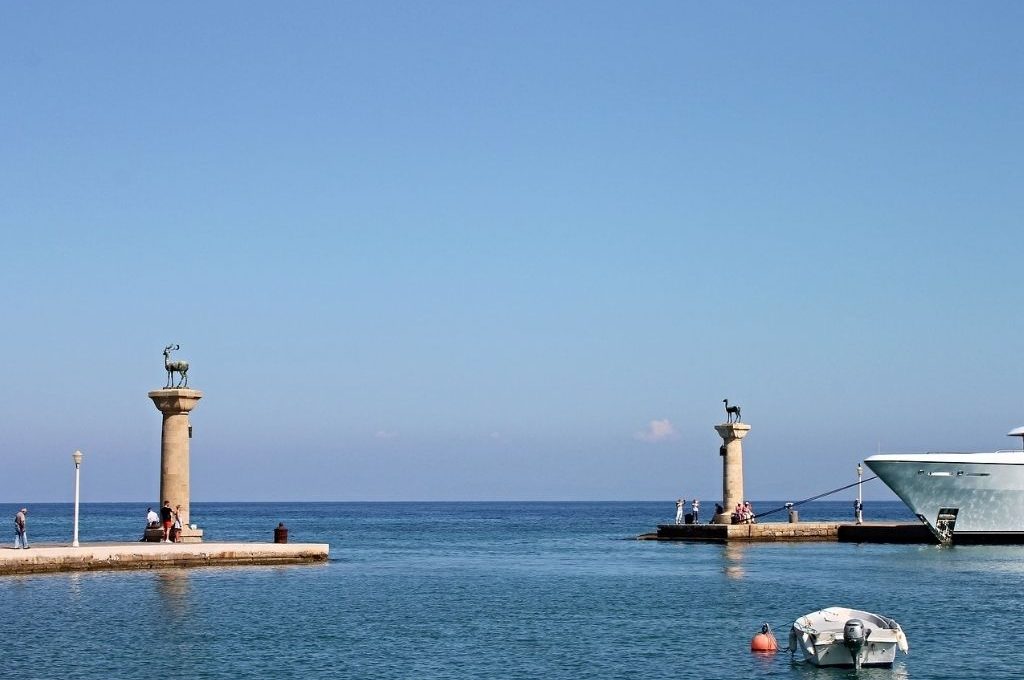The Colossus of Rhodes, a monumental bronze statue standing over 30 meters tall, was a dedication to the island’s protective deity, the sun god Helios. Commissioned to the sculptor Chares, a student of the renowned ancient sculptor Lysippus, the statue remained unfinished due to Chares’ untimely death. Accounts vary, with some sources suggesting he committed suicide, while others claim he was executed for mismanaging the budget allotted for the statute. Eventually, another sculptor completed the work, but specific details about this individual remain unclear.
🛎️ Reminder: To explore the Colossus of Rhodes with your digital tour guide, don’t forget to download Piri Guide! 😊
The Island of Rhodes
In the 3rd century BC, the island of Rhodes held significant importance as a major trade hub in the Mediterranean. Its thriving ports contributed to its growing wealth, and its strategic location enabled it to control maritime traffic in and out of the Aegean Sea. To safeguard trade routes, Rhodes and neighbouring nations signed neutrality agreements. Nevertheless, its prosperity and strategic position made it a target for ambitious leaders seeking to expand their influence. Among them was Antigonus I, a successor of Alexander the Great, who aimed to conquer Rhodes for his interests.
The Construction of the Colossus of Rhodes
The statue took over 10 years to complete. Chares, an ancient engineer, forged the bronze outer shell using plates supported by internal iron structures. To enhance stability, some sections were weighted with stones. Philo of Byzantium described the construction process, stating that the statue was cast in horizontal layers on-site. Each completed section was under a massive pile of earth before moving on to the next part. The base of the Colossus of Rhodes was likely around 18 meters in diameter, either circular or octagonal.
The Colossus of Rhodes
We’ve talked about the history of the Great Wall of China. Yet, we should remind you that you can find more on Piri Guide mobile app. Piri Guide detects your location, offers you the best travel routes, and starts telling you the hidden stories of wherever you are. All you have to do is to get your headphones or earbuds and follow the path at your own pace. Then, don’t set out for your trip before downloading the digital travel guide! 😊
Where is the Colossus?
Ancient writers did not provide any information about the exact location of the statue, leaving its whereabouts uncertain. However, manuscripts from an Italian traveller suggest that the original location was on the east side of the harbour. Later depictions of the statue, such as those from the Middle Ages, show that it stood with its two legs on different surfaces, allowing ships to pass under it. According to these depictions, one leg stood on the land where The Church of Evangelismos stands today, while the other leg was positioned towards Saint Nicholas Fortress.
Interesting Facts About the Colossus of Rhodes
- The Colossus of Rhodes was an enormous bronze statue of the Greek titan Helios, standing tall at around 98 feet (30 meters). That’s roughly the height of a modern 9-story building!
- Historians believe that the Colossus of Rhodes was an inspiration for the creation of the Statue of Liberty in the United States. 🗽
- After the earthquake, the remains of the Colossus were left lying on the ground for centuries. According to some sources, the ruins stayed there for almost 900 years! That’s some impressive staying power.
- Contrary to the popular image of the Colossus straddling the harbour entrance, historical accounts suggest that it stood on solid ground, near the harbour. So, no ships passed between its legs, but it was still a breathtaking sight.
What about exploring the Great Wall of China? If yes, check out our blog post “Great Wall of China: Dragon’s Backbone”! 👀




